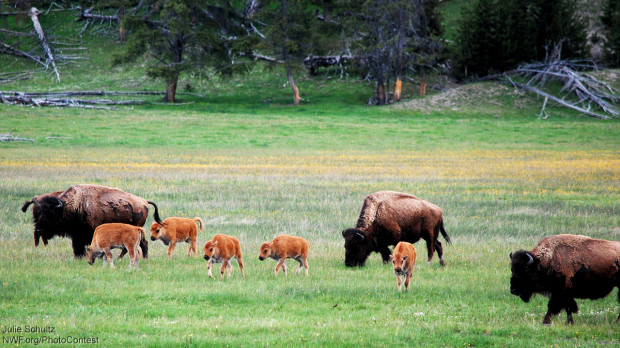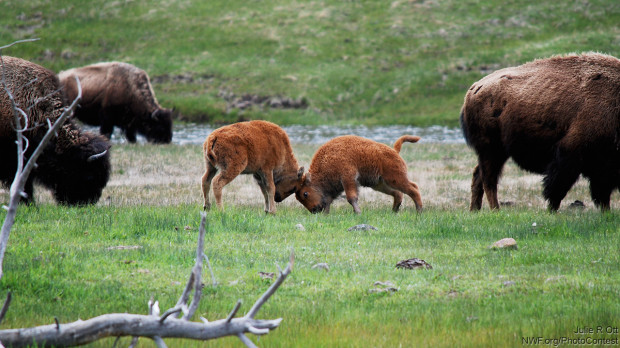We have much more to do and your continued support is needed now more than ever.
Give Yellowstone Bison a Year-Round Buffer Zone

This time, however, it’s a much different and important battle. As deep snows continue to accumulate on the high Yellowstone Plateau and bison begin their inevitable migration out of the national park, Montana’s Department of Fish Wildlife and Parks, and Board of Livestock once again are at odds over where America’s largest wild bison herd should be allowed to roam.
Government agents have begun capturing and sending to slaughter bison from Yellowstone National Park. They’ve announced plan to slaughter as many as 600 this winter. But while wildlife managers agree that the park can sustain just so many bison, significantly more habitat could be available to bison just outside the park.
Montana’s wildlife agency proposes to accommodate bison wandering over a larger area outside the park. The Board of Livestock has expressed opposition. It may be up to the public to break the logjam.
Breaking the Cycle
Usually, talk of expanding bison habitat is fraught with controversy. Some of Yellowstone’s bison (as well as its large elk population) are carriers for the disease brucellosis, a disease that causes cows to abort their calves. Ironically, cattle infected bison with brucellosis to begin with, but since the disease has effectively been eradicated from cattle in recent decades, the risk that bison might infect cattle has plagued bison management expansion efforts for decades.
The risk may be small – transmission of brucellosis from bison to cattle has never been documented under natural conditions – but it’s an ongoing concern for cattle ranchers.
The most contentious solution supported by livestock interests is vaccinating wildlife. One such program recently nixed by the Park Service included the use of “bio bullets” in an attempt to reduce the prevalence of – but never eliminate – brucellosis. Wildlife managers understand that spending countless resources on a vaccination program will not solve the disease issues that have haunted Yellowstone’s wildlife for nearly a century. Eradication of brucellosis would require every single elk and bison to be vaccinated in a region the size of Connecticut, a seemingly impossible feat.

You can help expand the buffer zone for bison to 400,000 acres. Urge Gov. Steve Bullock to support the plan.
It has taken an incredible amount of work over the past decade to get us to the point we’re at today. NWF has focused on voluntary grazing retirements, and this approach has won strong public support as a proactive, free-market method to solving conflicts involving wildlife and livestock. Our first key retirement for bison was the Horse Butte allotment, which resolved a significant conflict on the western side of the park. We then retired the Cache-Eldridge and Wapiti allotments in the Gallatin River drainage, which opens up a substantial area suitable for bison. Then we retired the Slip and Slide allotment north of the park by Gardiner.
But perhaps our most important grazing agreement involved private land. Working in partnership with Fish, Wildlife and Parks, NWF negotiated an agreement with the Church Universal and Triumphant to cease cattle grazing on the church-owned Royal Teton Ranch, near Yellowstone’s northern entrance. This has been a bottleneck for bison movement north of the park.
A History of Success
These retirements have led to the current situation where the risk of contact between bison and livestock is very low. And we know that the potential for disease transmission between bison and cattle is extremely low if separation is maintained during birthing periods.

As long as bison are effectively confined within the borders of the national park, managing the species’ population and movements will remain extremely difficult. And, as history has shown, it’s only a matter of time before the next bad winter sends bison into troubling territory—resulting in the untenable situation of hazing, capturing and slaughtering wildlife. By allowing bison to occupy sizeable habitat outside the park year-round, Fish, Wildlife and Parks, interested tribes, and Montana sportsmen will have the opportunity to play their constructive, traditional and socially acceptable roles to help manage the bison to a population that is suitable to livestock interests.
Less conflict, less risk, more opportunity and more room for bison to roam free: We have a historic opportunity to resolve a frustrating and longstanding conflict. The hard work’s been done. Now it’s just a matter of encouraging state officials to say “yes” to the win-win solution before them.
Give Bison Room to Roam
![]() Help give bison 400,000 acres to roam free from hazing and harassment. Urge Montana Gov. Steve Bullock to support the expansion plan.
Help give bison 400,000 acres to roam free from hazing and harassment. Urge Montana Gov. Steve Bullock to support the expansion plan.





















